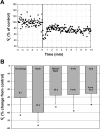Contributions of central and peripheral chemoreceptors to the ventilatory response to CO2/H+
- PMID: 20075260
- PMCID: PMC2853205
- DOI: 10.1152/japplphysiol.01059.2009
Contributions of central and peripheral chemoreceptors to the ventilatory response to CO2/H+
Abstract
The major objective of this review is to evaluate existing information and reach conclusions regarding whether there is interaction between P(CO(2))/H(+) stimulation of carotid (peripheral) and intracranial (central) chemoreceptors. Interaction is defined as a ventilatory response to simultaneous changes in the degree of Pco2/H(+) stimulation of both chemoreceptors that is greater (hyperadditive) or less (hypoadditive) than the sum of the responses when stimulation of each set of chemoreceptors is individually altered. Simple summation of the simultaneous changes in stimuli results in no interaction (i.e., additive interaction). Knowledge of the nature of central/peripheral interaction is crucial for determining the physiological significance of newer models of ventilatory control based on recent neuroanatomic observations of the circuitry of key elements of the ventilatory control system. In this review, we will propose that these two sets of receptors are not functionally separate but rather that they are dependent on one another such that the sensitivity of the medullary chemoreceptors is critically determined by input from the peripheral chemoreceptors and possibly other breathing-related reflex afferents as well. The short format of this minireview demands that we be somewhat selective in developing our ideas. We will briefly discuss the limitations of experiments used to study CO(2)/H(+) sensitivity and interaction to date, traditional views of the relative contributions of peripheral and central chemoreceptors to CO(2)/H(+) sensitivity, the evidence for and against different types of interaction, and the effect of tonic carotid chemoreceptor afferent activity on central control mechanisms.
Figures


References
-
- Berger W, Berger K, Berndt J, Giese K. Interaction of peripheral and central respiratory drives in cats. I. Effects of sodium cyanide as a peripheral chemoreceptor stimulus at different levels of CSF pH. Pflügers Arch 374: 205–210, 1978 - PubMed
-
- Bisgard GE, Forster HV, Klein JP. Recovery of peripheral chemoreceptor function after denervation in ponies. J Appl Physiol 49: 964–970, 1980 - PubMed
-
- Bisgard GE, Forster HV, Orr JA, Buss DD, Rawlings CA, Rasmussen B. Hypoventilation in ponies after carotid body denervation. J Appl Physiol 40: 184–190, 1976 - PubMed
-
- Busch MA, Bisgard GE, Forster HV. Ventilatory acclimatization to hypoxia is not dependent on arterial hypoxemia. J Appl Physiol 58: 1874–1880, 1985 - PubMed
Publication types
MeSH terms
Substances
Grants and funding
LinkOut - more resources
Full Text Sources

